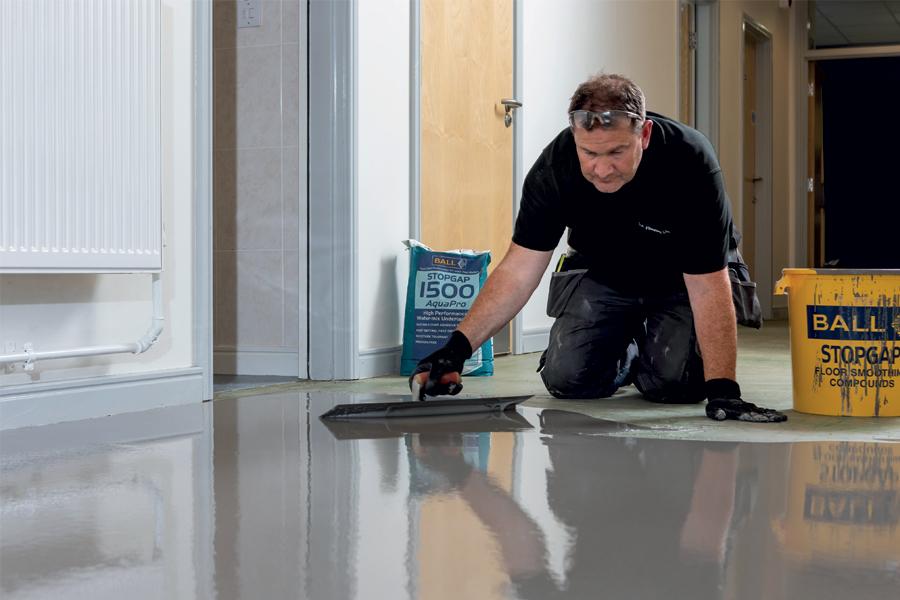FLOORING installations in social housing settings often face pressure to be completed as quickly as possible, if an installation is part of a refurbishment between one tenant moving out and another moving in, for example. Also, where work is taking place in public areas, such as corridors or foyers of apartment buildings, it’ll be desirable to minimise the time that access to homes is restricted.
For these situations, it’s invaluable to know about products that can significantly reduce the time required to install floorcoverings without compromising on finished results. Traditionally, installing new floorcoverings would have taken several days, leaving areas inaccessible in the meantime. Nowadays, fast-track products, including waterproof surface membranes, smoothing underlayments and adhesives are available that, when used together and applied correctly, can cut the time it takes to install floorcoverings down to less than a day.
Moisture management
The first step in any flooring installation should be to check the subfloor is suitably sound, smooth, and dry, including conducting a moisture test to determine subfloor moisture levels. Where a moisture test indicates that relative humidity (RH) levels within the subfloor are above 75% (65% if wood floorcoverings will be installed), a moisture management solution will be required to prevent floor failure. For these situations, single-coat waterproof surface membranes are available that will fully cure in as little as three hours to isolate residual construction moisture or rising damp where RH values are up to 98%.
Two-coat systems can create a barrier against residual construction moisture where RH values are up to 95% in less than two hours. The first coat requires 15-20 minutes curing time; the second requires a further 30 minutes to cure.
Smoothing underlayments
It’s recommended a smoothing underlayment is used to create a perfectly smooth base for the receipt of floorcoverings. Smoothing underlayments in particular have seen significant reductions in drying times, the result of advancements in cement technology. The fastest setting smoothing underlayment on the market is walk-on hard from 30 minutes and allows textile and resilient floorcoverings to be installed from as little as 45 minutes after application. Self-levelling properties also make them easy to apply with minimal trowel work.
Where flooring installations are part of a refurbishment and old adhesive residues, such as bitumen and carpet tile tackifiers, are present after the removal of old floorcoverings, contractors can save time by using a smoothing underlayment that has been specially formulated for use over old adhesive residues. This eliminates the need for mechanical preparation.
In most cases, when used in these situations, it’s not essential to prime the subfloor before the application of these smoothing underlayments, saving further time. It also means contractors can use the same product in situations where newly installed subfloors and areas with old adhesive residues present are next to each other.
The latest advancements in technology have enabled F Ball and Co to create what’s described as a fast-track, water-mix smoothing underlayment that can be applied over old adhesive residues, Stopgap 1500 AquaPro. ‘Such products have previously only been available in bag-and-bottle formulations. Just as with market-leading bag and bottle versions, the product is walk on hard in as little as 60 minutes after application and allows floorcoverings to be installed from four hours.’
Adhesive selection
Once the smoothing underlayment has cured, the contractor can then select a suitably fast-working adhesive to install appropriate floorcoverings. The choice of adhesive will often be determined foremost by what type of floorcoverings are to be installed and where, but there are options for when timesaving is a priority.
Fast-track, pressure sensitive adhesives are available that enable vinyl floorcoverings to be secured from just five minutes after application. These adhesives have been developed with a range of other specialist properties, including the ability to be used in areas subject to extreme temperature fluctuations.
Low odour solutions
When installing flooring in social housing settings that remain open to tenants, contractors should be sure to select a low-odour product to avoid any unpleasant smells that could cause irritation to residents. Advances in adhesive technology mean most adhesives are now formulated to be solvent-free and low odour and contractors will find solvent-free, low-odour adhesives that are also fast drying, for use with a wide variety of floorcoverings.
Checking compatibility
To prevent a substandard finish or even complete floor failure, contractors should always ensure adhesives are compatible with the chosen floorcoverings. To do this, they can consult the floorcovering manufacturer’s instructions. F Ball’s industry leading Recommended Adhesives Guide (RAG) also lists adhesives recommended for use with over 6,000 floorcoverings, produced by over 200 manufacturers, a continually updated version of which is available on F Ball’s website and as a free app. It’s also available as an A5 printed booklet.
www.f-ball.co.uk
Please click to view more articles about
> F Ball <

